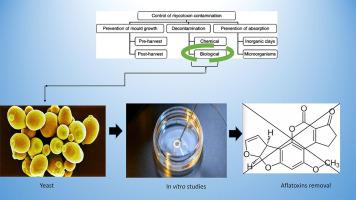Food Research International ( IF 8.1 ) Pub Date : 2020-07-04 , DOI: 10.1016/j.foodres.2020.109505 Fernanda B. Campagnollo , Amin Mousavi Khaneghah , Liliana L. Borges , Melina A. Bonato , Yadolah Fakhri , Caio B. Barbalho , Ricardo L.C. Barbalho , Carlos H. Corassin , Carlos A.F. Oliveira

|
The aflatoxins are hepatotoxic and carcinogenic metabolites produced by Aspergillus species during growth on crop products. In this regard, a systematic review to collect the quantitative data regarding the in vitro capacity of yeasts-based products to bind to aflatoxin B1 (AFB1) and/or aflatoxin M1 (AFM1) was performed. After screening, 31 articles which met the inclusion criteria was included and then the pooled decontamination of aflatoxins in the defined subgroups (the type of foods, pH, contact time, temperature, yeast species, and aflatoxin type) was calculated by the random effect model (REM). The overall binding capacity (BC) of aflatoxins by yeast was 52.05% (95%CI: 49.01–55.10), while the lowest and highest aflatoxins’ BC were associated with Yeast Extract Peptone (2.79%) and ruminal fluid + artificial saliva (96.21%), respectively. Regarding the contact time, temperature, pH and type of aflatoxins subgroups, the binding percentages varied from 50.83% (>300 min) to 52.66% (1–300 min), 50.71% (0–40 °C) to 88.39% (>40 °C), 43.03% (pH: 3.1–6) to 44.56% (pH: 1–3) and 59.35% (pH > 6), and 48.47% (AFB1) to 69.03% AFM1, respectively. The lowest and highest aflatoxins’ BC was related to C. fabianii (18.45%) and Z. rouxii (86.40%), respectively. The results of this study showed that variables such as temperature, yeast, pH and aflatoxin type can be considered as the effective factors in aflatoxin decontamination.
中文翻译:

酵母产品在培养基和食品中结合黄曲霉毒素B 1和M 1的体外和体内能力:系统评价和荟萃分析
黄曲霉毒素是曲霉菌种在作物生长过程中产生的具有肝毒性和致癌性的代谢产物。在这方面,进行了系统的综述,以收集有关酵母产品与黄曲霉毒素B 1(AFB 1)和/或黄曲霉毒素M 1(AFM 1)结合的体外能力的定量数据。)。筛选后,纳入符合纳入标准的31篇文章,然后通过随机效应模型计算确定亚组中黄曲霉毒素的合并去污(食品类型,pH,接触时间,温度,酵母菌种和黄曲霉毒素类型)。 (REM)。酵母对黄曲霉毒素的总结合能力(BC)为52.05%(95%CI:49.01–55.10),而最低和最高黄曲霉毒素的BC与酵母提取蛋白ept(2.79%)和瘤胃液+人工唾液有关(96.21 %), 分别。关于黄曲霉毒素亚组的接触时间,温度,pH和类型,结合百分比从50.83%(> 300分钟)到52.66%(1–300分钟),50.71%(0–40°C)到88.39%(> 40°C),43.03%(pH:3.1–6)至44.56%(pH:1-3)和59.35%(pH> 6)和48.47%(AFB 1)分别达到69.03%AFM 1。黄曲霉毒素的最低和最高BC分别与C. fabianii(18.45%)和Z. rouxii(86.40%)有关。这项研究的结果表明,诸如温度,酵母,pH和黄曲霉毒素类型等变量可被视为影响黄曲霉毒素净化的有效因素。



























 京公网安备 11010802027423号
京公网安备 11010802027423号